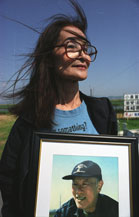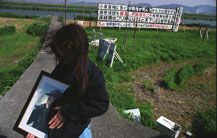Covering
Japan: Nagasaki Journal |
The Students
The Classes
Thirty-Year
Fight Pits Activist, Dam Interests
Yatiyo Yamashita, Whose Husband Won the Goldman Prize, Wants To Prevent
Filling of Isahaya Bay
By Jessi Hempel
Special to the Mercury News
(This story originally appeared in the San Jose Mercury
News on August 8, 2002. Click here
to view it on the Mercury News web site)
NAGASAKI, Japan – Yatiyo Yamashita
ignored signs marked "no trespassing" as she scaled the seven-foot
wall near the north gate to Isahaya Dam and picked her way across dried
and broken shells.
 Yatiyo Yamashita, 70, holds a picture of her late husband, Hirofumi, whose scientific work spurred the fight against the Isahaya Dam. |
The wall separates 14 square miles of Isahaya Bay from farms that rest in the shadow of volcanoes. At the mouth of the bay, a four-mile causeway holds back the Ariake Sea. As part of a landfill project, construction workers are depositing earth to make farmland from an area that was once one of Japan’s largest tidal flats.
"This mud used to be a meter thick
all around here," Yamashita said. "It was filled with mudskippers,
but now there are none left."
Eel-like mudskippers are one of 55 species native to Isahaya Bay that
environmentalists say are approaching extinction because of the dam. In
the 50 years since this controversial public works project began, it has
had many justifications, but its goal has remained the same: to create
arable land from Isahaya Bay.
In 1997, the first phase of the project was completed when 293 metal slabs
were dropped across the bay in guillotine fashion, sealing it off from
the Ariake Sea. And in 2006 when the landfill portion of the project is
scheduled to be completed, government officials say 4,446 acres of land
will be sold to farmers.
Those who support the public works project – mainly government officials
and local farmers – now say it is necessary for flood control following
natural disasters. "We need to establish a bank of land to protect
people from tidal waves and typhoons, and we need to build streams to
drain flood water efficiently," said Kenji Maeda, the chief advisor
of the Isahaya Dam Project Office. He also said the new land would be
sold to vegetable farmers who have not been able to plant their crops
in the local area because of a land shortage.
Those opposed – including some fishermen and environmentalists –
say the dam has led to a decrease in the amount of fish in the Ariake
Sea and a decline in the seaweed harvest.
"This is a genocide of the fish," said Biologist Mikio Azuma
of Nagasaki University. "The tidal flats of Isahaya Bay were a filter
for the Ariake Sea. They purified the water. Now the sea is polluted and
the fish are dying." Azuma said the muddy tidal flats separated volcanic
sediment from the seawater and facilitated chemical reactions that released
oxygen into the sea.
Yatiyo Yamashita’s late husband, Hirofumi Yamashita, spent his life
studying this process. His scientific findings spurred him to speak out
against the project. He and his wife have been vocal in the project’s
opposition movement since the 1970s when they first joined efforts with
local labor unions and fishermen.
In 1997, after the dam’s closing was broadcast nationally, that
protest movement grew stronger. "The news program spurred a wave
of environmental awareness that hadn’t existed in Japan," said
Minoru Okuda, an environmental activist in Tokyo.
In response, the Yamashitas formed the Isahaya Wetland Emergency Rescue
Task Force. Together with fishermen and seaweed farmers, who feared a
decline in their yield, they organized a campaign against the project.
"This place was packed," Yamashita said, pointing to the back
of her home. "Some people stayed in here and some even slept at the
dam."
 |
Their protest movement gained international
attention and support in 1998, when Hirofumi Yamashita was given a Goldman
Prize, a $100,000 award for environmental activism.
University economics professor Jun-ichi Himeno remembers Hirofumi Yamashita
as a scientist so passionately devoted to his activism that he seemed
a little crazy. But Himeno called Yamashita and his wife symbols of environmental
activism.
"Nongovernmental organizations and local nonprofits have rallied
around them," said Himeno. "And now their lobby matters more.
The government can’t make decisions anymore without consulting environmentalists."
After Yamashita’s death, his wife has worked to keep the movement
alive. Yet many of those who opposed the dam have switched camps. In one
local fishermen’s union, more than half of the fishermen became
construction workers when they could no longer support themselves as fishermen.
"Though I’m sympathetic to the fishermen, it is a great blow
to our work," she said.
The $2 billion public works project plays an important economic role in
the community. Officials are reluctant to provide detailed information
about the project, but Himeno estimates it employs more than 500 people.
And a local newspaper reports nearly 40 construction companies have contracts
to work on it.
"Local industry development matters more than environmental issues,"
said Himeno.
He calls the dam "dictatorship development," a pet project of
top officials. "The Governor of this prefecture is the son of a member
of the Ministry of Agriculture who decided on the original budget for
the project," he said. Then he added that the powerful Ministry of
Agriculture, which funded part of the project, has close ties to the construction
industry.
With the construction lobby and government support for the project, and
with an increasing percentage of the community turning to the project
for employment, it’s likely that the tidal flats will be obliterated.
Every day with every bit of landfill the muddy flats of Isahaya Bay become
more irretrievable.
But Yamashita continues to speak out because these tidal flats are her
husband’s legacy. Burying them is like burying her husband, and
she cannot watch this without being moved to action. That’s why
she continues to put 15-hour days into the bimonthly newsletters she mails
to 400 supporters.
And as often as she can, she scales the wall to bring visitors –
students, reporters, environmentalists – to dig in the mud that
was once Isahaya Bay.

